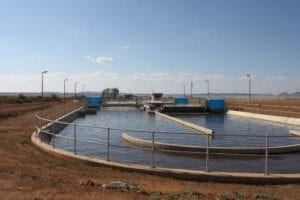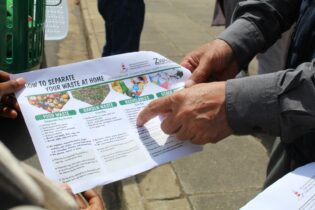Despite a long wait, and having only handed over the site in July 2011, the upgrade of the Colesberg Wastewater Treatment Works was completed in the first half of this year, Lerato Mokoena, programme manager: Regional Bulk Infrastructure Programme at the DWA, tells Chantelle van Schalkwyk.
While Colesberg was added to the Regional Bulk Programme priority list when the Regional Bulk Infrastructure Programme (RBIG) initially started in 2006, it was only during June 2011 that the Regional Bulk Infrastructure Funding Agreement was signed between the Department of Water Affairs (DWA) and Umsobomvu Local Municipality to implement the upgrading of the Colesberg Wastewater Treatment Works (WWTW) Phase 4. The project itself, which was estimated to have cost in the region of R25.3 million, was jointly funded by the local municipality through the Municipal Infrastructure Grant (MIG), whose contribution equalledapproximately R5.8 million, and the DWA contribution through the RBIG, which totalled approximately R19.4 million. Despite the agreement only being signed in June 2011, the consulting engineer, in this case WorleyParsons (which also acted as the project manager), was already appointed during 2005. As Mokoena explains, the delay between this date and the eventual project commencement was because the municipality struggled to secure sufficient funds for the programme and numerous discussions took place between the municipality, the Department of Human Settlements and the DWA. The project specs included upgrades, construction and installation of:- a biological reactor
- clarifier
- anaerobic ponds
- RAS/WAS pump station
- sludge pump station
- sludge Ponds
- chlorination contact channel
- interconnecting pipework
- site works, landscaping and fencing.
Despite being located on a key thoroughfare, the town only has a population of approximately 17 259 people, with estimates indicating that 77% of all residents of Colesbergare classified as indigents.
As a result, the IDP Review in 2008/2009 indicated that there was a total housing backlog of 2 248, of which 2 200 were required in the town of Colesberg itself. At the time the WWTW upgrade was proposed, Colesberg was in the process of developing 2 354 stands, referred to as the Ouboks Development, as one of the flagship housing projects in the province – and also likely to place substantial strain on the local drinking water and wastewater treatment networks. On-site successes The key challenge experienced during the implementation of the project was hard rock formation on the pump stations, clarifier and reactor excavations.However, these were easily overcome as the project has been executed according to the initial construction drawings. With regards to skills, there were eight local general labourers employed by the contractor from the local Colesberg community and as they reportedly performed very well on-site, the contractor is also utilising them as semi-skilled labourers on a WWTW project he is currently busy with in Colesberg, with one of the eight labourers being put on a three-month probation before possibly being appointed permanently to the contractors staff. He is currently working as a supervisor on one of the contractor’s sites in the Eastern Cape. As the project has been completed, the Umsobomvu Local Municipality – as the initial implementing agent – has taken ownership of the new and improved infrastructure, as well as taking over responsibility for the operations and maintenance of the newly constructed WWTW from February of this year. Mokoena concludes that, since the plant has been successfully upgraded, it is estimated it is now able to serve a population of 30 280, almost double the current population, and 3 864 households – serving the community not only now, but well into the future. When investigating the lessons learnt from the project, the crucial message that comes across is the importance of appointing a well-qualified and competent contractor, especially on projects of this nature where production against time and budget restrictions is of extreme importance. “Also the timely appointment of a competent consulting engineering firm from the project inception right through to implementation is important for maintaining the project momentum and continuity,” concludes Mokoena.






